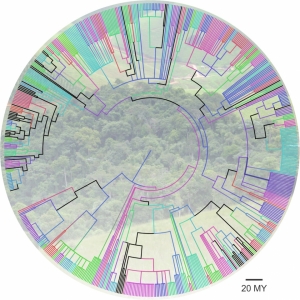News
Journal of Ecology: LEEP researchers and collaborators published a pioneer article about fragmentation effects on phylogenetic structure and diversity
published in
Effects of landscape configuration and composition on phylogenetic diversity of trees in a highly fragmented tropical forest
Download it here:
http://www.leep.ufv.br/pt-BR/publicacao/effects-of-landscape-configuration-and-composition-on-phylogenetic-diversity-of-trees-in-a-highly-fragmented-tropical-forest
1. Fragmentation of tropical forests is a major driver of the global extinction crisis. A
key question is understanding how fragmentation impacts phylogenetic diversity,
which summarises the total evolutionary history shared across species within a
community. Conserving phylogenetic diversity decreases the potential of losing
unique ecological and phenotypic traits, and plays important roles in maintaining
ecosystem function and stability.
2. Our study was conducted in landscapes within the highly fragmented Brazilian
Atlantic forest. We sampled living trees with DBH ≥4.8 cm in 0.1 ha plots within
28 fragment interiors and twelve fragment edges to evaluate the impacts of
landscape configuration, composition and patch size, as well as edge effects, on
phylogenetic diversity indices (PD, a measure of phylogenetic richness; MPD,
phylogenetic distance between individuals in a community in deep evolutionary
time; and MNTD, phylogenetic distance between each individual and its nearest
phylogenetic neighbour).
3. We found that PD and MPD were correlated with species richness, while MNTD
was not. Best models suggest that MPD was positively related to edge density
and negatively related to the number of forest patches, but that there was no
effect of landscape configuration and composition metrics on PD or MNTD, or on
standardized values of phylogenetic structure (sesPD, sesMPD, sesMNTD),
which control for species richness. Considering all selected models for
phylogenetic diversity and structure, edge density and number of forest patches
were most frequently selected.
4. With increasing patch size, we found lower PD in interiors but no change at
edges, and lower sesMNTD regardless of habitat type. Additionally, PD and
sesMNTD were higher in interiors than at edges.
5. Synthesis. Changes in MPD and sesMNTD suggest that extirpation of species at
edges or in highly fragmented landscapes increases the dominance of species
within a subset of clades (phylogenetic clustering), likely those adapted to
disturbance. Smaller patch sizes are phylogenetically diverse and overdispersed,
probably due to an invasion of edge-adapted species. Conservation must
enhance patch area and connectivity via forest restoration; pivotally, even small
forest patches are important reservoirs of phylogenetic diversity in the highly
threatened Brazilian Atlantic forest.